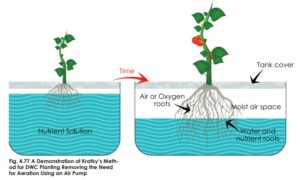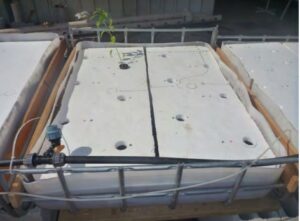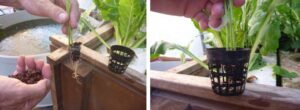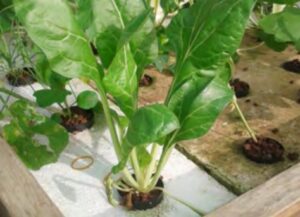The Kratky Method
Author Food and Agriculture Organization of the United Nations.
The Kratky method: Another simpler approach to ensuring sufficient oxygen for plants roots using the DWC method is to leave a space of 3-4 cms in between the polystyrene and the water body inside the trough.
This technique is called the Kratky method which sees the polystyrene sheets suspended 3-4 cm above the water rather than floating on top to allow air to circulate around the plant roots.
This approach removes the need for air stones in the trough as sufficient amounts of oxygen in the air is supplied to the roots.
Another advantage of this method is the avoidance of direct contact of the plants with water, which reduces the risks of plant diseases at the collar zone (between root and leaf). Furthermore, the increased ventilation due to the space favors the heat dissipation from water, which is ideal in hot climates.

• Venturi’s: Low tech venturi’s are another simple technique to increase the oxygen levels in the canals. Simply speaking, low tech venturi’s are small sections of pipe (i.e. 20mm pipe, 5cms long) thinner than the main water pipe (i.e 25mm thick) which are then inserted into the main pipe.
As the water in the 25mm pipe is forced through the thinner 20mm pipe section, it creates a jet effect as the water exits the 5cm section of 20mm pipe (see fig. 4.78-4.82). This jet steam allows you to then cut a hole into 25mm pipe just after the 20mm insert which then sucks the surrounding air into the water flow.
Ventur’s integrated into each inflow pipe just before the canal facilitates the dissolving of much greater amounts of oxygen into the trough water. They can also help stabilize the dissolved oxygen levels in the canals if the air pump fails. See the further reading section at the end of this manual for more sources of information on venturis.
• Finally, do not add any fish into the canals as they will eat the plant roots. However, the presence of some fish species in the canals like guppies in tropical and temperate areas (who will not eat plant roots) can get rid of the innumerable mosquito larvae which can become a huge nuisance to workers and neighbors.
Plant techniques for DWC units:
The polystyrene sheets should have a certain number of drilled holes to fit the net cups used for supporting each plant. The amount and location of the holes is dictated by the vegetable type and the distance desired between the plants (i.e. 20-30 holes per square meter for lettuce at 300 grams harvest weight).
See step by step annex for further details on how to drill the holes.

Take one seedling and place it into a net cup allowing the end of the roots to dangle below the bottom of the cup. Gently fill the remaining space in the net cup with 8mm gravel giving support to the seedling.

Afterwards, place the filled net cup into one of the holes drilled into the polystyrene making sure it fits tight with no threat of it falling into the trough. It is also possible to simply plant a seed straight into the net cups on top of the gravel.
This method is recommended if vegetable seeds are accessible as it avoids the transplant shock seedlings experience when replanting. When harvesting, make sure you remove the whole plant (including roots) from the trough.

Note: It is recommended to sterilize the next cups and polystyrene sheets by soaking them with weak bleach for a couple of hours every 6 months.
READ MUCH MORE INSIDE…
The Kratky Method

 Our 100% Money Back Guarantee:
Our 100% Money Back Guarantee:
If for any reason you decided within 30 days that “The Kratky Method” isn’t for you, simply notify us by email and we’ll gladly refund your money – no questions asked. That’s our Ironclad Guarantee! The risk is entirely ours! You absolutely have nothing to lose!
Your Name and Email will Never Be Shared or Given to Anyone.
We keep our subscriber’s privacy sacred. We do not sell or rent your personal information to other parties. What’s more you can always unsubscribe at any time!
Warmest Regards,
Coyalita Linville
Copyright © 2023 – 2024 Sunrise-Sunset-Nature-Gardens.com. All Rights Reserved Privacy Policy – Earning Disclaimer – Terms of Use – Contact Us
Open modal